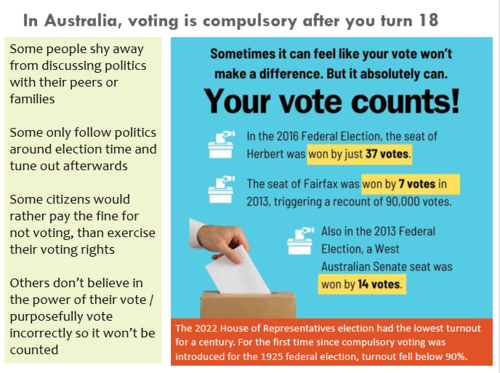



A PowerPoint which I think Legal Studies / Civics teachers will find helpful. If you use it, and like it, please give me a positive star rating / review.
It is designed to simultaneously introduce students to the topics for their practice exam (voter apathy) and their real exam (lack of representation in parliament). It begins with unpacking Australia’s demographics using results from the census (August 2021). This includes information about the percentage of Australians in each generation, the percentage of Aboriginal and/or Torres Strait Islander citizens, the percentage of Australians who speak another language at home, the various religious affiliations of our citizens, the types of households, percentages of home owners vs renters, information about long term health conditions experienced, the educational qualifications we hold & the hours worked and common professions.
Then there is an infographic which shows the make up of parliament (2016-2019) which shows the breakdown using categories of Australia, house of reps, senate, the liberal /national coalition party and Labor party. The categories shown are gender age, sexual orientation, education level, non-English speaking background and Indigenous.
This is followed by an explanation of party allegiances and how party members rarely “cross the floor.” Afterwards the term apathy is introduced as well as voter apathy aka political apathy / electoral disengagement. There is a graph showing the number of people who lodge a vote as a percentage of all who are enrolled to vote from 1925-2016 showing a decline since 2007. There is a clip from YouTube where Craig Reucassel discusses voter apathy. Information is provided about the fact that in other countries, voting is optional and some of the cons of this. Following this, students are given their seen sources for their practice exam which they are to look at in class and for homework.
NB: My lessons have been designed for use in Australian classrooms and will often feature examples from Queensland legislation.
Something went wrong, please try again later.
This resource hasn't been reviewed yet
To ensure quality for our reviews, only customers who have purchased this resource can review it
Report this resourceto let us know if it violates our terms and conditions.
Our customer service team will review your report and will be in touch.